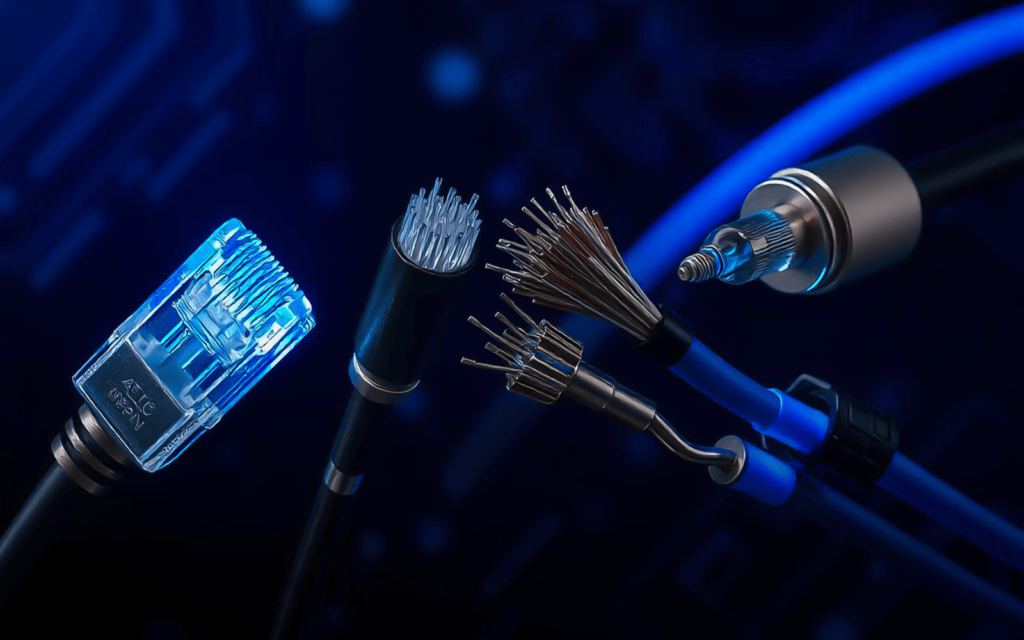Understanding Structured Cabling
Structured cabling is a standardized wiring infrastructure that streamlines network and low-voltage cabling within buildings or campuses. Governed by standards set by the EIA/TIA TR42 committee, structured cabling ensures compatibility, enhances network performance, and allows for efficient network management. It provides an organized framework that simplifies system upgrades and ensures seamless interoperability between devices.
In simple words, they are a network infrastructure that integrates multiple cabling elements to create a cohesive, organized system enabling flexible reconfigurations, minimizes downtime, and supports efficient troubleshooting. Additionally, they ensure a high level of network performance.

What are the key Benefits of Structured Cabling?
- Making changes or additions becomes a simpler task. Moves, additions, and changes are facilitated within a centralized distribution area, eliminating the need for long patch cords.
- Reduces the likelihood of errors, ensuring fewer interruptions in service.
- Cable management and tracing are streamlined, saving time on troubleshooting and maintenance.
- A structured system presents a clean, organized appearance, as it avoids visible tangled wires and preserves an orderly workspace.
- Structured cabling optimizes signal integrity, reducing interference and signal loss, thus boosting network performance.
Types of Cabling in Structured Cabling Systems
Structured cabling employs several types of cables, each serving distinct purposes. Here are the following:
- Ethernet Cables
- Fiber Optic Cables
- AC Power Cables
- Coaxial Cables
- Special Data Transmission Cables
- Twisted Pair Cables

These diverse cabling types cater to various network needs, ensuring reliable and efficient data transmission.
Components of a Structured Cabling System
A well-designed structured cabling system comprises several critical components:
- Patch Panels
- Data Jacks
- Cross-Connect Cables
- Cable Trays and Raceways
These components work cohesively to create a tidy, efficient network infrastructure, commonly used in commercial settings to maintain organization and ease of access.
Structured Cabling vs. Point-to-Point Cabling
While structured cabling provides an organized framework, point-to-point cabling connects each device directly to the network equipment without a centralized structure. Unlike structured cabling, point-to-point setups can become cluttered, difficult to troubleshoot, and pose airflow challenges, which may affect equipment performance.

Drawbacks of Not Using Structured Cabling
An unstructured cabling setup can lead to issues such as:
- Increased Downtime: A disorganized cabling layout raises the risk of accidental disconnections and makes troubleshooting difficult.
- Poor Airflow: Point-to-point systems congest spaces around network equipment, limiting airflow and potentially causing overheating.
Setting Up a Structured Cabling System
For a reliable setup, partner with a company specializing in structured cabling design and installation. This ensures expert management, minimizing disruption to business operations and accelerating project completion. Professional installers can also ensure compliance with current standards, guaranteeing long-term system reliability.
Why Choose Oxiore for Structured Cabling?
We specialize in structured cabling systems designed for maximum durability and adaptability. Its is recommended to implement at least CAT5e or CAT6 cabling to ensure future-ready performance.
Reach us today for a consultation to discuss how we can optimize your network infrastructure with a structured cabling solution that supports your long-term growth.
Trust Oxiore Systems for industry-leading structured cabling services to future-proof your network!
FAQs
What is structured cabling and why is it important?
Structured cabling is a standardized system that organizes and connects network hardware across a building or campus. It helps reduce clutter, simplifies troubleshooting, and improves overall network reliability and performance.
How is structured cabling better than traditional point-to-point cabling?
Unlike point-to-point cabling, structured cabling provides a centralized, organized setup. This makes it easier to manage, reduces downtime, prevents airflow blockages, and keeps the workspace neat and professional.
What types of cables are used in a structured cabling system?
Structured cabling systems commonly include Ethernet cables, fiber optic cables, coaxial cables, twisted pair cables, AC power cables, and other data transmission cables—each serving specific functions within the network.
Can structured cabling support future network upgrades?
Yes. Structured cabling is designed to be scalable and adaptable. With CAT5e or CAT6 cables, your network can easily handle upgrades and higher data speeds as your business grows.
Why should I hire professionals like Oxiore for structured cabling installation?
Professional installation ensures your cabling is compliant with industry standards, future-proofed, and optimized for peak performance. Oxiore brings expertise, speed, and minimal disruption to your operations.


